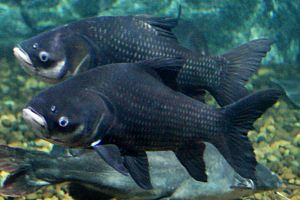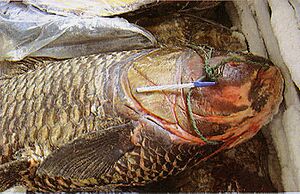Giant barb facts for kids
Quick facts for kids Giant barb/Siamese giant carp |
|
|---|---|
 |
|
| Conservation status | |
| Scientific classification | |
| Genus: |
Catlocarpio
|
| Species: |
siamensis
|
The giant barb, also known as the Siamese giant carp or just Siamese carp, is the biggest type of carp fish in the world! Its scientific name is Catlocarpio siamensis. You might hear it called trei kól reăng in Khmer or kraho in Thai. These amazing fish live only in the big rivers of Southeast Asia, like the Mekong, Chao Phraya, and Mae Klong in countries like Cambodia, Laos, Thailand, and Vietnam. Sadly, there are far fewer giant barbs now because their homes are being damaged and too many are being caught. This means they are now considered critically endangered, which is very serious.
Contents
Where Giant Barbs Live
Giant barbs usually hang out in big, deep pools along the edges of large rivers. But when the seasons change, they might swim into smaller waterways, flooded areas, and even forests that are underwater. Young giant barbs often live in smaller streams and swampy places. They can also get used to living in ponds and canals. These fish often live in pairs, meaning you'll usually find them with a partner.
Their Migratory Life
Giant barbs are migratory fish. This means they travel to different places throughout the year to find the best spots for eating and having babies. They are slow-moving fish that mostly eat algae, tiny plant-like organisms called phytoplankton, and fruits from plants that grow in flooded areas. They rarely, if ever, eat other animals. In the lower part of the Mekong River, young giant barbs are often seen in October.
What Giant Barbs Look Like
The giant barb has a head that looks quite big compared to its body. It does not have any barbels, which are whisker-like feelers that some fish have around their mouths.
Size and Weight
The giant barb is one of the largest freshwater fish on Earth! It's probably the biggest fish in the Cyprinidae family, which includes all carps and minnows. Some people say it can grow up to 3 m (9.8 ft) long, which is about the length of a small car! It can also weigh as much as 300 kg (660 lb), which is heavier than a giant panda. However, it's rare to catch such huge ones today. For example, no giant barb weighing more than 150 kg (330 lb) has been caught in Cambodia since 1994. Today, the biggest ones are usually around 1.8 m (6 ft) long. The current record for weight is 105 kg (231 lb) for a fish caught in Thailand in 2019.
Unique Biology
This fish is special because it is a tetraploid. This means it has four sets of each chromosome in its cells, instead of the usual two sets that most animals have.
Protecting the Giant Barb
Sadly, not many giant barbs live long enough to become adults these days. The biggest dangers to them are habitat loss and overfishing. Habitat loss means their homes are being damaged by things like pollution and dams built on rivers. Overfishing means too many fish are being caught, so there aren't enough left to have babies and keep the population strong.
Population Decline
The number of giant barbs has dropped very quickly. For example, in Cambodia, people caught 200 tonnes (200 long tons; 220 short tons) of giant barbs in 1964. But by 1980, only about 50 fish were caught, and by 2000, only 10! This sharp decline shows how serious the problem is. Because of this, the giant barb is listed as Critically Endangered on the IUCN Red List. It has even completely disappeared from the Chao Phraya River.
Conservation Efforts
To help protect this amazing fish, the Kingdom of Cambodia made the giant barb its national fish in 2005. This was done to make more people aware of the need to save this species.
Scientists are also working hard to help. In 2005, the giant barb was successfully bred in captivity for the first time in Vietnam. This means they learned how to get the fish to reproduce in special centers. In 2012, it was also successfully reproduced in another breeding center in Vietnam. In 2010, a breeding center in Vietnam released 50,000 young giant barbs into a river. However, a study showed that only a few of them survived long enough to grow big.
Raising Giant Barbs
In recent years, raising giant barbs has become popular in Vietnam. This is because they are worth a lot of money. Two breeding centers in southern Vietnam provide about 1 million young giant barbs to farmers every year.
Growth and Harvest
When giant barbs are kept in floating cages in rivers, they grow very fast. They can gain 7 kilograms (15 lb) to 9 kilograms (20 lb) in a single year! If they are raised in ponds where they mostly eat natural algae, they grow a bit slower, gaining 2 kilograms (4.4 lb) to 5 kilograms (11 lb) per year. Farmers usually harvest giant barbs after three years when they weigh 6 kilograms (13 lb) to 10 kilograms (22 lb). But some farmers keep their fish in ponds for more than seven years, letting them grow to 50 kilograms (110 lb) before harvesting them.



